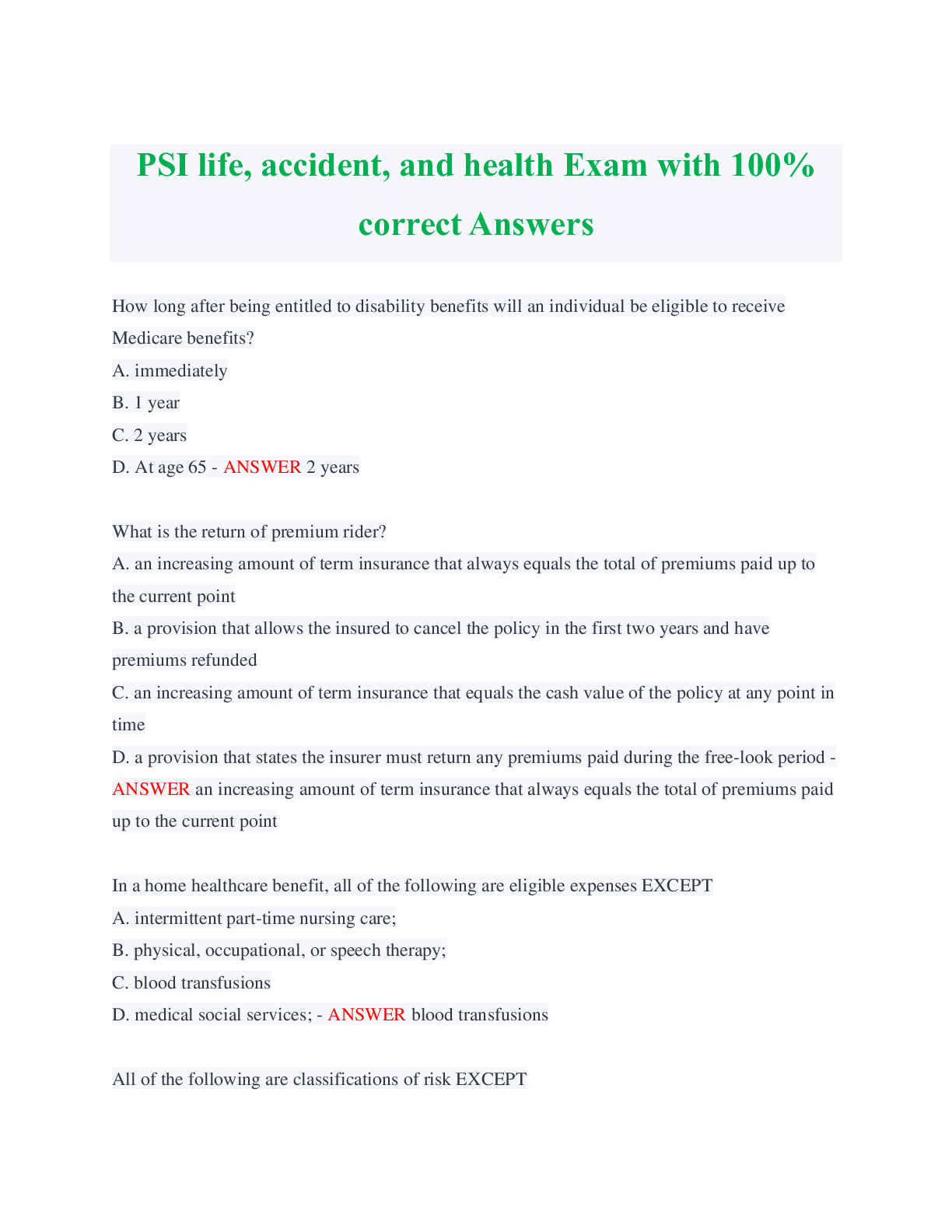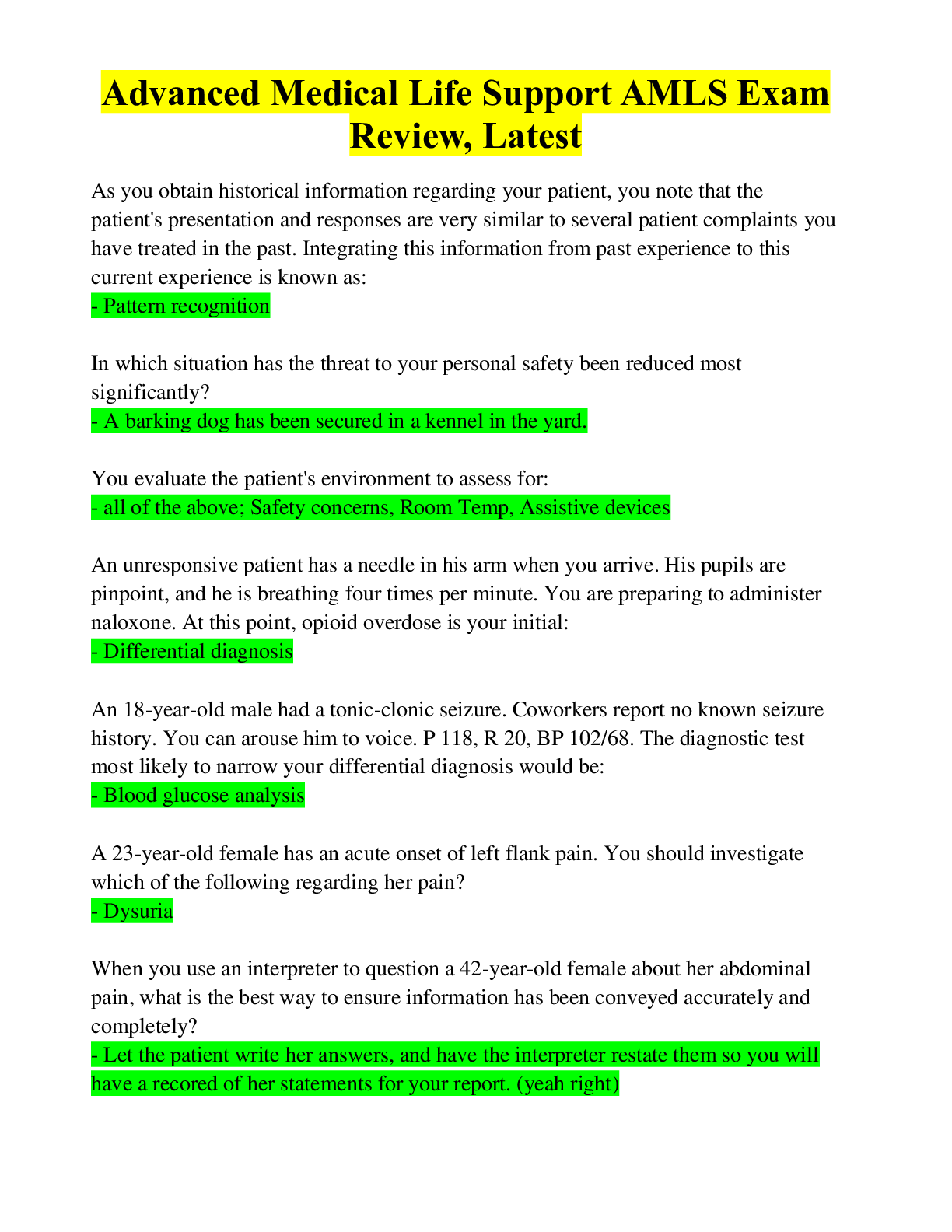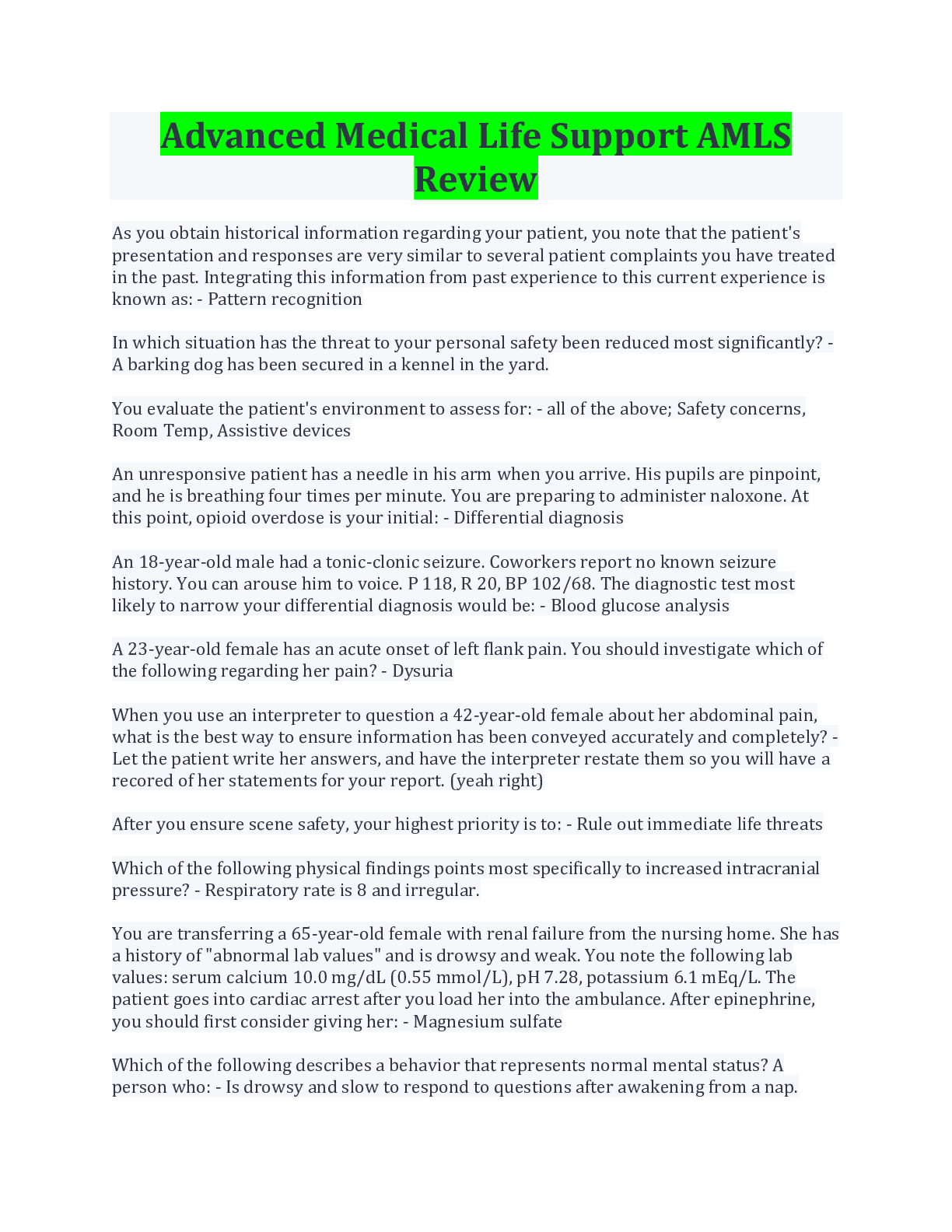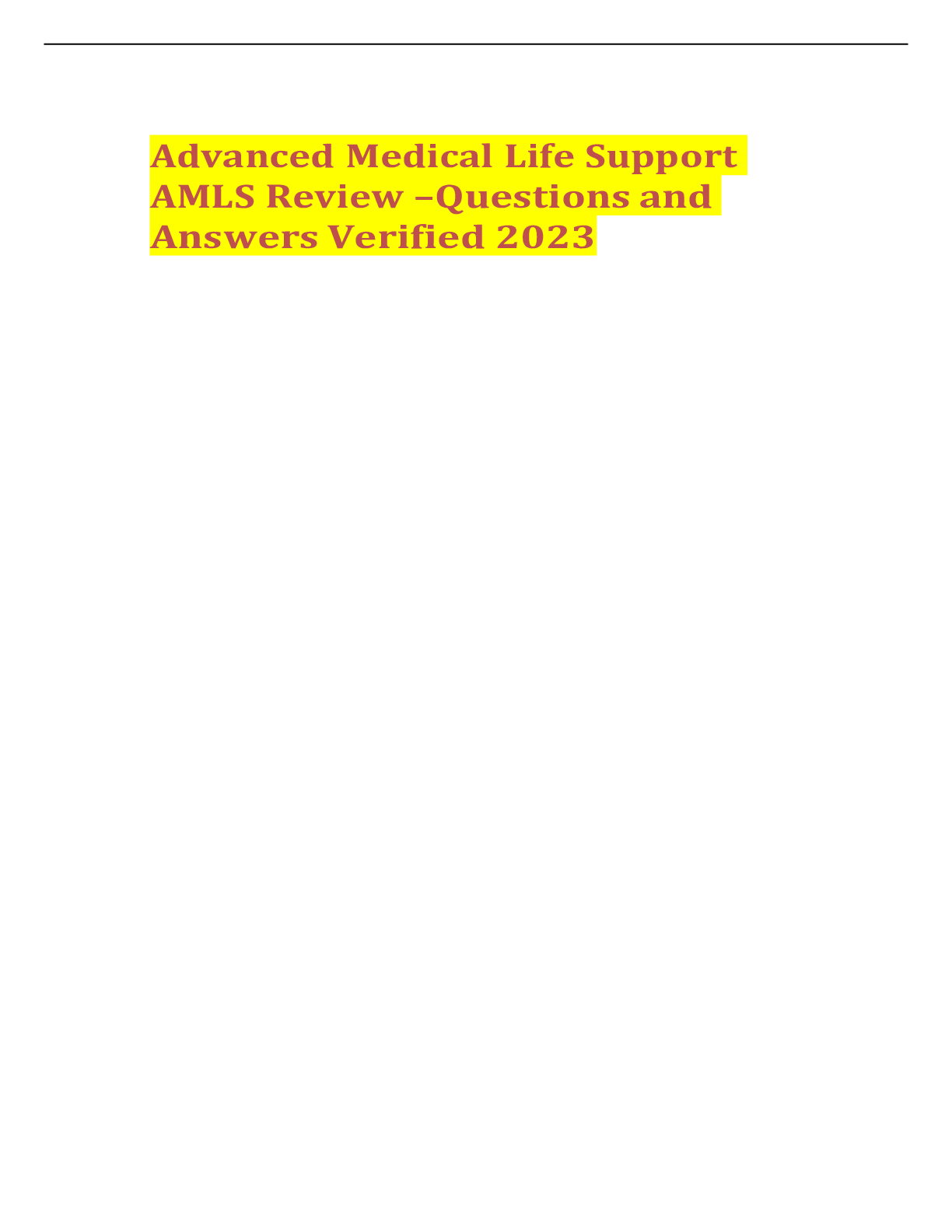Advanced Medical Life Support AMLS Review 2022/2023
Document Content and Description Below
As you obtain historical information regarding your patient, you note that the patient's presentation and responses are very similar to several patient complaints you have treated in the past. Integra... ting this information from past experience to this current experience is known as: - ANSWER Pattern recognition In which situation has the threat to your personal safety been reduced most significantly? - ANSWER A barking dog has been secured in a kennel in the yard. You evaluate the patient's environment to assess for: - ANSWER all of the above; Safety concerns, Room Temp, Assistive devices An unresponsive patient has a needle in his arm when you arrive. His pupils are pinpoint, and he is breathing four times per minute. You are preparing to administer naloxone. At this point, opioid overdose is your initial: - ANSWER Differential diagnosis An 18-year-old male had a tonic-clonic seizure. Coworkers report no known seizure history. You can arouse him to voice. P 118, R 20, BP 102/68. The diagnostic test most likely to narrow your differential diagnosis would be: - ANSWER Blood glucose analysis A 23-year-old female has an acute onset of left flank pain. You should investigate which of the following regarding her pain? - ANSWER Dysuria When you use an interpreter to question a 42-year-old female about her abdominal pain, what is the best way to ensure information has been conveyed accurately and completely? - ANSWER Let the patient write her answers, and have the interpreter restate them so you will have a recored of her statements for your report. (yeah right) After you ensure scene safety, your highest priority is to: - ANSWER Rule out immediate life threats Which of the following physical findings points most specifically to increased intracranial pressure? - ANSWER Respiratory rate is 8 and irregular. You are transferring a 65-year-old female with renal failure from the nursing home. She has a history of "abnormal lab values" and is drowsy and weak. You note the following lab values: serum calcium 10.0 mg/dL (0.55 mmol/L), pH 7.28, potassium 6.1 mEq/L. The patient goes into cardiac arrest after you load her into the ambulance. After epinephrine, you should first consider giving her: - ANSWER Magnesium sulfate Which of the following describes a behavior that represents normal mental status? A person who: - ANSWER Is drowsy and slow to respond to questions after awakening from a nap. Which assessment evaluates at least one aspect of cranial nerve function? - ANSWER Cincinnati Prehospital Stroke Scale A 72-year-old male had a syncopal episode in church. His wife said he has been complaining of a headache for about a week. He has early Alzheimer's disease. Home medicines include Lipitor and Exelon (rivastigmine). Which of the following questions may help narrow your differential diagnosis? - ANSWER Did he fall or hit his head recently? A 56-year-old female experiences a sudden onset of headache and blurred vision during yoga class. Her right eyelid is drooping, and the pupil on that side is small compared to the left pupil. You should take her to a hospital with: - ANSWER Specialized neurologic and vascular capability A 32-year-old complains of headache and dizziness. He vomited once and is walking with a staggering gait. His blood pressure is 148/72, pulse 92, respirations 20. He has a steady stare up toward his right ear. Which sign or symptom makes you consider intracerebral hemorrhage more strongly than migraine headache as a cause of his emergency? - ANSWER Abnormal gaze Which is the most reliable indicator that ventilation should be assisted in a patient with altered mental status? - ANSWER End-tidal CO2 is 60 mm Hg A 24-year-old male complains of sudden explosive headache . He asks you to lower the lights. He has vomited once. Which of these findings would increase your index of suspicion for subarachnoid hemorrhage? - ANSWER Stiff neck Which of the following findings indicates the need to increase the rate of ventilation in a intubated patient you suspect to have an epidural hematoma? - ANSWER Unilateral blown pupil A 25-year-old helmeted female was thrown from a horse. She is complaining of weakness in her upper extremities. You ask her to close her eyes and identify whether you are moving her thumb up or down. She is unable to do so. This indicates she does not have normal: - ANSWER Proprioception A 44-year-old male is postictal after a witnessed grand mal seizure. He is arousable to light pain and is presently snoring. His vital signs are BP 142/86, P 120, R 20, Sa02 98%. You should: - ANSWER Insert a nasopharyngeal airway A 25-year-old woman was involved in a motor vehicle collision. Her initial vital signs were BP 122/80 mm Hg, P 128 bpm, R 20 breath/min. Which of the following findings on repeat assessment would indicate that she is developing shock? - ANSWER Pulse pressure 32 mm Hg Which gland is responsible for some of the vasoconstriction in shock? - ANSWER Pituitary The primary mechanism for septic shock is: - ANSWER Widespread inflammatory response A 24-year-old male injuries in a shallow diving incident. Which assessment finding would you anticipate if he is developing neurogenic shock? - ANSWER Heart rate 58 bpm Which intervention for patient in shock prevents an increase in myocardial oxygen demand? - ANSWER Maintain normal body temperature Which diagnostic test most accurately assesses the presence and magnitude of anaerobic metabolism? - ANSWER Lactic acid Which patient is at highest risk for non traumatic obstructive shock? - ANSWER 22-year-old who is 38 weeks pregnant A 19-year-old female is flushed, itchy, and wheezing after eating crab legs. Her vital signs are BP 90/64 mm Hg, P 128 bpm, R 24 breaths/min. Which intervention is indicated first? - ANSWER Epinephrine intramuscular A 62-year-old male is vomiting coffee-ground emissions. Which of his home medicines may make it more difficult to control his bleeding? - ANSWER Plavix Shock related to tension pneumothorax is most directly secondary to: - ANSWER Decreased preload The most common sign or symptom found in patients with pulmonary embolism is: - ANSWER increased respiratory rate A 52-year-old male with a history of alcoholism complains of pleuritic chest pain. He states the pain increases when he swallows. He appears very ill and has subcutaneous emphysema around his neck. You suspect: - ANSWER Boerhaave's syndrome A 73-year-old male awakens suddenly at 0200 complaining of dyspnea. You find him in tripod position. Crackles are audible around his scapulae. He has a history of hypertension. You suspect his symptoms are related to: - ANSWER Left heart failure A 70-year-old male suspected to have a dissecting aortic aneurysm has a blood pressure of 170/102 mm Hg. This sign may indicate: - ANSWER The renal arteries are involved Which of the following patients is at highest risk for pericardial tamponade? - ANSWER 55-year-old with end-stage lung cancer If you administer nitroglycerin to a patient with ST-elevation in leads II, III and aVF, you should be prepared to: - ANSWER Administer a bolus of normal saline if the blood pressure drops A 45-year-old male with a history of hypertension complains of chest "pressure," about a 5 on a scale of 1 to 10, for 20 minutes. He just "wants to be checked out." Vitals signs and 12-lead ECG are normal. You have already administered oxygen and aspirin. You should next: - ANSWER Administer nitroglycerin 0.4 mg sublingual. An 82-year-old female complains of chest heaviness. She has sinus tachycardia. Her vital signs are BP 108/72 (equal in both arms), P 98, R 20. Her breath sounds are clear in all fields. Aside from myocardial infarction, what should you suspect her chest pain could be related to? - ANSWER Pulmonary embolism A 40-year-old male has chest pain reported as an "elephant sitting on my chest." He confides that he snorted cocaine 5 minutes before his pain began. You should first administer: - ANSWER Lorazepam, 2 mg IV A 65-year-old female complains of chest pain that feels like "aching" in her chest. It has become progressively worse over several days. Her temperature is 38.3 degrees C (101F). Which finding will help narrow your differential diagnosis to pericarditis? - ANSWER ST-segment elevation in everylead Your patient is agitated and sweaty. Her vital signs are BP 107/108 mmHG, P 132 bpm, and R 20/min. Her pupils are dilated, and her hands are trembling. These signs and symptoms may be associated with: - ANSWER Alcohol withdrawal Which source provides the most detailed information related to hazardous materials? - ANSWER Material Safety Data Sheets A 2-year-old male is found chewing on berries from a lily of the valley plant. Predict his vital signs. - ANSWER BP 70/50 P 70 bpm A 24-year-old female took 24 diphenhydramine tablets. Her vital signs are BP 86/54 mm Hg, P 110 bpm, R 20/min. What other sign or symptom should you anticipate. - ANSWER Seizures The family of a 72-year-old male is worried about their father. His blood glucose is 80 mg/dL (4.4 mmol/L). His rate and depth of breathing are increased, and he is sleepy and weak. He take metformin (Glucophage). You suspect his signs and symptoms may be related to: - ANSWER Lactic acidosis A farmer was spraying his barn when he became ill. His heart rate is 60 bpm, and his blood pressure is 88/50 mm Hg. Tears are streaming down his cheeks, and he is vomiting. What toxidrome does this clinical picture fit? - ANSWER Cholinergic Which of the following biological warfare agents causes serious neurologic symptoms that may include paralysis? - ANSWER botulism A 22-year-old female is found at a party unresponsive and breathing approximately 8 breaths/min. Her skin is gray. Which of the following signs or symptoms will confirm your suspicion that the opioid toxidrome is causing her emergency? - ANSWER Pupils 2 mm and equal Your patient is reported is reported to have taken an overdose. She has a history of anxiety disorder and depression. She is unresponsive, and vital signs are BP 110/70, P 125 bpm, R 20/min. Her ECG shows right bundle branch block. You expect she has taken: - ANSWER Amilytriptyline You respond to a warehouse for "multiple patients with difficulty breathing." From a hallway, you see your patient lying in a room with two other people who don't seem to be breathing. He calls out to you, saying he can't breathe. You should first: - ANSWER Stage at a safe distance. Which agency oversees the compliance, tracking and reporting, and guidelines for preventing transmission of bloodborne pathogens in the workplace? - ANSWER OSHA You are treating a patient who has been diagnosed with herpes simplex type 1. He exhibits no signs or symptoms at this time. He is in which stage of the communicable disease? - ANSWER Latent Which of the following is an occupational exposure incident? - ANSWER Blood sprays in your face when a child with a face laceration sneezes Antibodies that are produced from lymphocytes are known as what kind of immunity? - ANSWER Humoral Hepatitis A (HAV) is transmitted by which route? - ANSWER Oral-fecal The best measures you can take to reduce your risk of acquiring hepatitis C from an occupations exposure is to: - ANSWER Use standard precautions Which sign or symptom can help diagnose headache from meningococcal meningitis? - ANSWER Petechial rash A patient infected with which disease should be assessed for pneumonia, encephalitis, and myocarditis? - ANSWER Rubeola While treating a trauma patient, you lacerate your hand. Your bleeding hand comes in contact with the blood of the patient. What action is most important to increase your chance of appropriate follow-up? - ANSWER Notify the receiving facility and your designated infection control officer immediately. Your adolescent patient presents with a fever, malaise, sneezing, and paroxysmal spasmodic coughing phases. Which infectious disease would you suspect? - ANSWER Pertussis A 33-year-old male has right lower quadrant abdominal pain and vomiting. Five minutes after you administer a dose of ondansetron, he vomits forcefully. His vitals are now BP 102/72, P 52, R 20. The alteration in his vital signs is likely related to: - ANSWER Vagal stimulation Your patient is complaining of a cramping pain around her umbilical area that "won't let up." This is most suggestive of disease involving the: - ANSWER Appendix A 43-year-old male with diffuse abdominal pain and vomiting has a yellowish discoloration of his sclera. This indicates he has excess serum: - ANSWER Bilirubin A 42-year-old male complains of a gnawing, sever pain in the epigastric area that radiates to his back. His vital signs are T 102*F, BP 94/68, P 128, R 24. Your highest priority intervention would be to administer: - ANSWER Normal saline, 250 mL bolus A 22-year-old patient at a restaurant is complaining of abdominal pain and diarrhea. Her skin is flushed, and she feels faint. Her vital signs are: BP 98/50, P 124, R 24. Which finding in her SAMPLER history is most likely to guide your differential diagnosis for this patient? - ANSWER Illness began about 10 minutes after eating A 45-year-old female complains of right upper quadrant abdominal pain. To help confirm your differential if you suspect cholecystitis you should: - ANSWER Ask her to take a deep breath as you press upward into her right upper quadrant An 18-year-old, 35-kg female is vomiting copious amounts of bright red blood. The most likely diagnosis would be: - ANSWER Mallory-Weiss syndrome An 88-year-old female complains of nausea, vomiting, and constipation. Her abdomen is tender to palpation and appears distended. Her lungs are clear, and her vital signs are: BP 104/76, P 120, R 20. An appropriate action would be to: - ANSWER Infuse normal saline at 250 mL/h. A 45-year-old male complains of severe epigastric pain radiating to his back. He has vomited several times. His history is significant for alcohol abuse and hypertension. You suspect an inflammatory condition of a gastric accessory organ. To confirm your differential on physical exam you should assess for: - ANSWER Psoas sign When assessing your patient's medication history, which would indicate the patient may have a preexisting ulcer? - ANSWER Famotidine Your patient complains of discomfort in his hand as you inflate the cuff to asses the blood pressure. You note flexion of the wrist and adduction of his fingers. What endocrine disorder do you suspect? - ANSWER Hypoparathyroidism A 47-year-old female is anxious and complaining of heart palpitations. She reports a recent diagnosis of "thyroid problems." On exam you note exophthalmos. Her vital signs are BP 108/72 mm Hg, P 128 bpm, R 20/min. Interventions should include administration of: - ANSWER Intravenous fluids Which assessment finding(s) should you anticipate in a patient who has myxedema? - ANSWER Dry yellow skin What treatment should you anticipate in a patient with a history of Addison's disease who has the following vital signs: BP 94/58 mm Hg, P 124 bpm, R 20/min? - ANSWER Hydrocortisone What findings should you anticipate on the physical examination of a patient with Cushing's syndrome? - ANSWER Blood glucose 180 mg/dL (10 mmol/L) When serum glucose drops below 70 mg/dL (3.9 mmol/L), which of the following occurs? - ANSWER Epinephrine secretion increases A 22-year-old male complains of a 2-day history of abdominal pain. His skin is flushed, and he has a fruity odor on his breath. Assessment reveals BP 106/54 mm Hg, P 128, R 28, glucose 568 mg/dL. Your highest priority intervention would be to: - ANSWER Infuse normal saline rapid IV Which patient would be an appropriate candidate for immediate intravenous administration of sodium bicarbonate? - ANSWER 45-year-old who complained of chest pain and is now in cardiac arrest and unresponsive to treatment A 72-year-old complains of a headache and being depressed, intermittent twitching in the facial muscles, and general weakness over the past 2 weeks. She has a medical history of hypoparathyroidism. The ECG reveals a prolonged QT segment. During transport she has a seizure. Which electrolyte imbalance is most likely? - ANSWER Hypocalcemia A 62-year-old hunter was lost in a swampy area. When you begin to care for him, he is lethargic, disoriented, and has a body temperature of 31 degrees C (87.8F). His ECG shows bradycardia. What should be your treatment priority? - ANSWER Rapid rewarming [Show More]
Last updated: 2 years ago
Preview 1 out of 8 pages

Buy this document to get the full access instantly
Instant Download Access after purchase
Buy NowInstant download
We Accept:

Reviews( 0 )
$10.00
Can't find what you want? Try our AI powered Search
Document information
Connected school, study & course
About the document
Uploaded On
Nov 22, 2022
Number of pages
8
Written in
Additional information
This document has been written for:
Uploaded
Nov 22, 2022
Downloads
0
Views
124
















latest 2023 graded A+.png)


